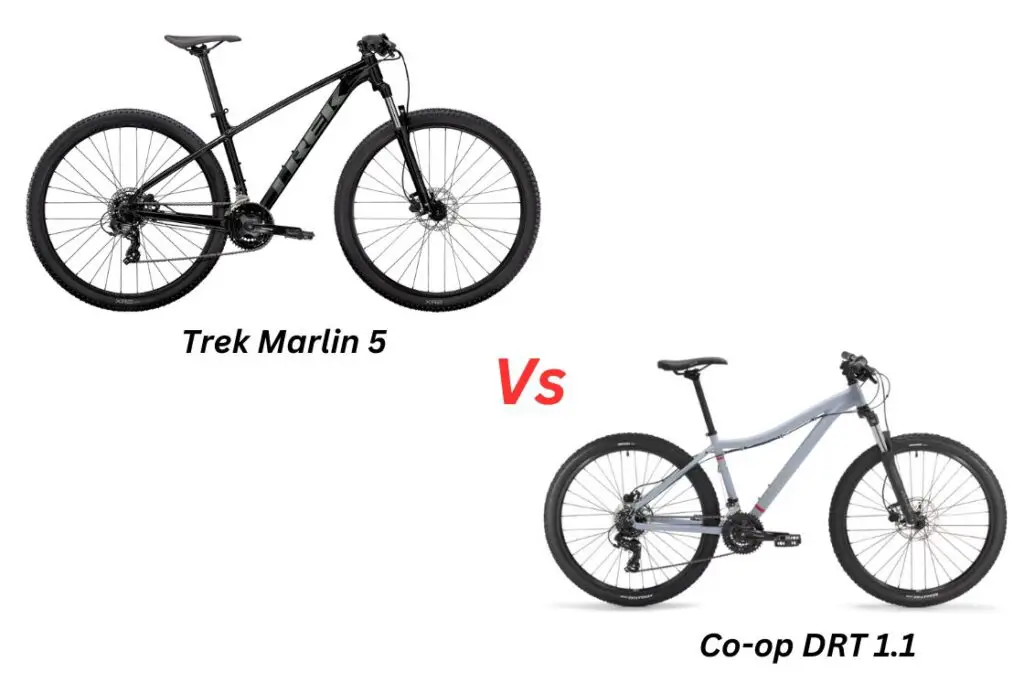
If you are looking for a budget-friendly hardtail mountain bike, you might be interested in comparing two popular models: the Trek Marlin 5 and the Co-op DRT 1.1.
Both bikes are made of aluminum and have similar features, but there are also some differences that might affect your decision.
Here, we will compare these two bikes based on their specifications, performance, and price.
| Feature | Trek Marlin 5 | Co-op DRT 1.1 |
|---|---|---|
| Frame Material | Aluminum | Aluminum |
| Wheel Size | 27.5″ or 29″ (depending on size) | 27.5″ |
| Front Suspension | 100mm | 100mm |
| Fork | Suntour XCE28, coil spring | Suntour (no model name or adjustment options) |
| Fork Adjustability | Preload, lockout feature | No adjustability |
| Drivetrain | 3×7 | 3×7 |
| Derailleurs | Shimano Tourney and Altus | Shimano Tourney |
| Shifters | Shimano Tourney | Shimano Tourney |
| Crankset | Prowheel | Shimano |
| Cassette | SunRace | Shimano |
| Brakes | Hydraulic disc | Hydraulic disc |
| Price | $599 | $599 |
Specifications
The Trek Marlin 5 and the Co-op DRT 1.1 have some common specifications, such as hydraulic disc brakes, 100mm front suspension, and 3×7 drivetrain. However, they also differ in some aspects, such as wheel size, fork, and components.
Wheel size:
The Trek Marlin 5 comes with either 27.5″ or 29″ wheels, depending on the frame size. The Co-op DRT 1.1 only has 27.5″ wheels.
The larger wheels of the Marlin 5 offers more stability and speed on rough terrain, while the smaller wheels of the DRT 1.1 might be more agile and responsive.
Fork:
The Trek Marlin 5 has a better fork than the Co-op DRT 1.1.
The Marlin 5 has a Suntour XCE28 fork with coil spring and preload adjustment, while the DRT 1.1 has a Suntour fork with no model name or adjustment options.
The Marlin 5’s fork also has a lockout feature, which allows you to lock the suspension for more efficiency on smooth surfaces.
Components:
The Co-op DRT 1.1 has slightly better components than the Trek Marlin 5.
The DRT 1.1 has Shimano Tourney derailleurs and shifters, while the Marlin 5 has a mix of Tourney and Altus components.
The DRT 1.1 also has a better crankset (Shimano vs Prowheel) and cassette (Shimano vs SunRace).
Read Also: Rockhopper Elite vs. Expert: Which One Should You Buy?
Performance
Both bikes are designed for cross-country riding, which means they can handle moderate trails and dirt roads, but not extreme downhill or technical terrain. They are also suitable for commuting and casual riding on paved surfaces.
Trek Marlin 5
The Trek Marlin 5 might perform better on rougher trails, thanks to its larger wheels and better fork. It also has higher gearing, which means it can go faster on flat or downhill sections.
However, it might be harder to climb steep hills or accelerate quickly with the higher gears.
Co-op DRT 1.1
The Co-op DRT 1.1 performs better on smoother trails or tight corners, thanks to its smaller wheels and lower gearing. It also has better components, which might offer more reliability and durability over time.
Price
Both the Co-op DRT 1.1 and the Trek Marlin 5 come with an attractive price tag of $599.
This makes them both affordable options for riders looking to get into mountain biking without breaking the bank.
It’s worth noting that prices can vary based on location, sales, and discounts, so it’s a good idea to keep an eye out for any potential deals or promotions that may further reduce the cost of these bikes.
Read Also: Specialized Status vs. StumpJumper: Compared
Which One is Better?
The Trek Marlin 5 and the Co-op DRT 1.1 are both decent hardtail mountain bikes for beginners or casual riders who want to explore different terrains without breaking the bank. However, they have some differences that might suit different preferences or needs.
If you prefer larger wheels, better fork, and higher gearing, you might like the Trek Marlin 5 more.
If you prefer smaller wheels, better components, and lower gearing, you might like the Co-op DRT 1.1 more.
